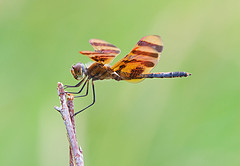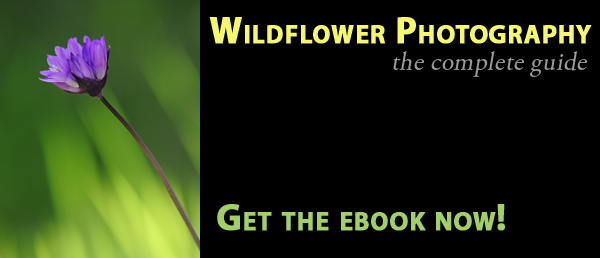
But, if you’re looking to photograph some of the not so annoying ones, here are a few tips:
#1 – Don’t cast your shadow on them
Insects love the Sun, so if you cast a shadow on them, they’ll almost always fly away. I’ve also noticed that if you scare them in this way, they’re unlikely to come back to that same spot. So, when you’re approaching an insect to photograph, be very careful about where your shadow falls.
#2 – Look for them in cooler weather
Insects need the heat of the Sun to use their wings, so when it’s cooler out, it’s harder for them to move around–they’re less likely to fly away as you approach them. Sometimes on overcast summer days, I’ve been able to get my lens just inches away from butterflies that seem to be “stuck” to a flower.
Or, you could also try looking for insects around sunrise or sunset, when they’ll often be “sleeping” on a plant somewhere, allowing you to get super close. If you’re lucky, you’ll even catch them with some dew on them 🙂
#3 – Wait patiently for them to return if you scare them away
If you happen to scare an insect away from a great perch with a great background, don’t worry. Many insects tend to use the same perch over and over again. So, be patient, and wait for them to return. Also, remember not to cast your shadow on their perch while they’re gone, since they’ll unlikely return if it’s in the shade.
Check out my Dad’s free ebook for more great tips!
A couple years ago, my Dad (Vic Berardi) wrote a great ebook on photographing dragonflies. It’s packed with a ton of great tips that also apply to photographing just about any insect. So, if you’re new to PhotoNaturalist, and haven’t checked it out yet, please do! 🙂
Click here to read more about the ebook.
What did I miss?
If you have another trick for photographing insects, please share it with us by leaving a comment below! Thanks 🙂
If you enjoyed this article, and would like to read more, please signup for our free email newsletter.
 About the Author: Steve Berardi is a naturalist, photographer, computer scientist, and founder of PhotoNaturalist. You can usually find him hiking in the San Gabriel Mountains or the Mojave Desert, both located in the beautiful state of California.
About the Author: Steve Berardi is a naturalist, photographer, computer scientist, and founder of PhotoNaturalist. You can usually find him hiking in the San Gabriel Mountains or the Mojave Desert, both located in the beautiful state of California.

Early in my photography career I used to shadow them in shadows. I learned!
I’ve just started experimenting with “not blocking their door of escape.” It seems so far, that some creatures will feel less threatened and continue their business allowing a few extra seconds to photograph. Also pre setting the camera will be less intimidating as one gets up closer.
Thanks, Steve
Hello Steve,
I love your very informative articles. I am relatively new to Macro Photography and want to know the lens I should be using with my Nikon D300 to get really tack sharp images.
Thanks. Bob
Good suggestions. I recently played hide and seek around a flower with a crab spider until I realized that my shadow as I moved was sending the spider to the other side of the flower. When I moved differently, I got my shot.
One other point–especially for larger insects, be sure to get the eye in focus.
I like it.
A second great benefit of early morning/latte evening is great shadows that help give depth and definition — especially for very small insects taken with a macro lens and small DOF.
The one thing that helped me more than ANYTHING,,was setting my camera to “back focus”,,whereby you use your thumb to focus on the back of the camera using the + or – button on my 50d. Set it in your Custom Functions. This allows you to continually focus with your thumb and follow your moving subject and co.plete the shot woth your pointing finger. You will miss very few shots using this method
reby you use yoir thumb to fucus
Another trick I use is to stick a small dead tree branch into the ground where I want the dragon fly to be in relation to my vantage point. They love the small twig to sit on,,,break off most of the twigs except for the one where u want the dragonfly to be. I also use this method around my bird feeders in order to get more natural shots. I hate seeing a great shot but spoiled(in my opinion) by having plastic feeders etc. In the frame.
Great ideas Roy! I will start to use them during my daily shooting experiences. Thanks for the assistance I really appreciate it. Bob.
Good tips…thanks for sharing.